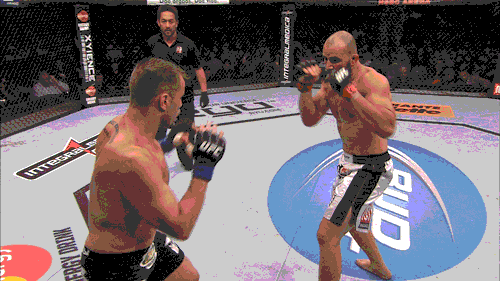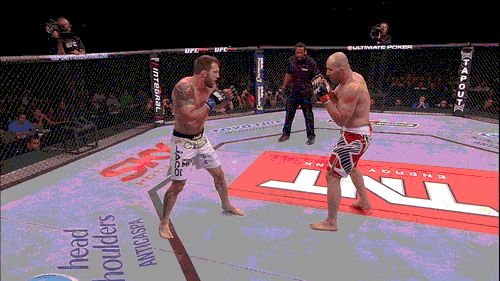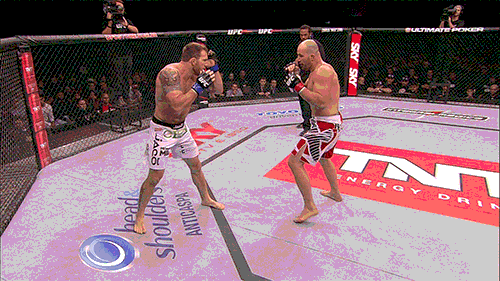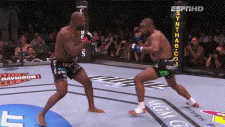Photo by Josh Hedges/Zuffa LLC
This weekend's main event between Glover Teixeira and Rashad Evans could end up being another example of stolen momentum. Just as Junior dos Santos was able to rebound from four so-so bouts by ending the terrific winning streak of Ben Rothwell, Rashad Evans is positioned here to pull something of a fast one and catapult himself back into title contention.In 2014 Glover Teixeira went into a bout with light heavyweight champion Jon Jones with twenty-two victories under his belt but being rather untested against the cream of the crop. When Jones put a comprehensive martial arts clinic on the Brazilian banger, Teixeira dropped off of many fan's radars. Things were made worse as Teixeira immediately suffered another convincing loss when he was out wrestled by Phil Davis. But Teixeira has been quietly rebuilding and in 2015 was able to stop Ovince St. Preux and Patrick Cummings, both respected light heavyweight contenders. Submitting St. Preux is particularly impressive because this was the first time that OSP had been stopped in eighteen fights—the last time being when he was a 3-4 novice in the sport. If St. Preux gives even a decent account of himself against Jones, you can expect to hear plenty about that loss to Teixeira in hyping future bouts.Back when Teixeira was coming up to his title shot against Jon Jones, I wrote a piece called Glover Teixeira in One Punch. In that piece I demonstrated the limited nature of Teixeira's game on the feet, relying almost entirely on throwing the overhand right as a lead—attempting to time it as the opponent stepped in with his own punch—and following up with the left hook. Glover Teixeira lives and dies by this cross counter. Remember, a cross counter is a looping blow which travels across the opponent's straight, not just a straight blow from the rear hand. Over and over, like a monkey with a miniature cymbal, Teixeira will try to clap this across his opponent's punches.
Over and over, like a monkey with a miniature cymbal, Teixeira will try to clap this across his opponent's punches.
 Some assert that when Jon Jones took Teixeira apart he did so in Teixeira's 'domain'. In truth, Jones did an excellent job of avoiding Teixeira's favorite combination and picked him apart at range with kicks. When the two moved in close, it was Jones' choice to drive Teixeira into the fence. This might look like a fair trade on first glance, but that is absolutely not the case.
Some assert that when Jon Jones took Teixeira apart he did so in Teixeira's 'domain'. In truth, Jones did an excellent job of avoiding Teixeira's favorite combination and picked him apart at range with kicks. When the two moved in close, it was Jones' choice to drive Teixeira into the fence. This might look like a fair trade on first glance, but that is absolutely not the case. Notice that Jones has one foot in front of the other, he is in a stance and able to turn his hips and move his weight from one foot to the other and generate power. Teixeira's feet are level, he is essentially punching with just his upper body. When he is not hitting, Jones keeps his head pinned either under Teixeira's head (perfect cage wrestling position), or on Teixeira's chest (classic infighting position) where Teixeira cannot hit him with any power. Try throwing an uppercut two inches in front of your own sternum, good luck with that. Then notice that Jones (the man with the longer reach) uses his elbows so that his blows travel inside the line of Teixeira's wide swings. Jones also folds behind his elbows, so that they protect his jawline from connections, while moving his head throughout. This was the single finest use of infighting for MMA that I have yet seen. Masterful.More on stance and taking it away in episode one of Ringcraft:Contrast Jones' pressuring, but still defensively minded infighting with Ryan Bader folly against Teixeira. Teixeira is on the cage, check. But Bader takes a step back onto the end of Teixeira's reach. What's more, Teixeira is no longer under physical pressure: there's nothing to stop him moving his feet and transitioning his weight. He turns his weight into a beastly overhand and decks the wrestler.
Notice that Jones has one foot in front of the other, he is in a stance and able to turn his hips and move his weight from one foot to the other and generate power. Teixeira's feet are level, he is essentially punching with just his upper body. When he is not hitting, Jones keeps his head pinned either under Teixeira's head (perfect cage wrestling position), or on Teixeira's chest (classic infighting position) where Teixeira cannot hit him with any power. Try throwing an uppercut two inches in front of your own sternum, good luck with that. Then notice that Jones (the man with the longer reach) uses his elbows so that his blows travel inside the line of Teixeira's wide swings. Jones also folds behind his elbows, so that they protect his jawline from connections, while moving his head throughout. This was the single finest use of infighting for MMA that I have yet seen. Masterful.More on stance and taking it away in episode one of Ringcraft:Contrast Jones' pressuring, but still defensively minded infighting with Ryan Bader folly against Teixeira. Teixeira is on the cage, check. But Bader takes a step back onto the end of Teixeira's reach. What's more, Teixeira is no longer under physical pressure: there's nothing to stop him moving his feet and transitioning his weight. He turns his weight into a beastly overhand and decks the wrestler. Teixeira's return to form hasn't coincided with him learning a whole heap of new skills though. He did a decent job with his jab against Patrick Cummings but each jab was still outnumbered by three or four overhand attempts.
Teixeira's return to form hasn't coincided with him learning a whole heap of new skills though. He did a decent job with his jab against Patrick Cummings but each jab was still outnumbered by three or four overhand attempts. Teixeira retains the trait of throwing himself bodily into his overhand attempts. Ryan Bader demonstrated this amply with his feints in his bout against Teixeira in 2013. A bout in which Bader was getting the better of Teixeira on the feet until the knockout.
Teixeira retains the trait of throwing himself bodily into his overhand attempts. Ryan Bader demonstrated this amply with his feints in his bout against Teixeira in 2013. A bout in which Bader was getting the better of Teixeira on the feet until the knockout.
 The heavy transition of weight also makes Teixeira incredibly susceptible to the inside low kick. You will remember that smoother kickboxers repeatedly used this one against Mike Zambidis as he attempted to take their heads off.
The heavy transition of weight also makes Teixeira incredibly susceptible to the inside low kick. You will remember that smoother kickboxers repeatedly used this one against Mike Zambidis as he attempted to take their heads off. The other great problem with Teixeira's game as a whole is that he doesn't really know where he wants to be. Typically a striker wants to keep range and use long, straight blows to facilitate that without getting taken down. A wrestler wants to throw right hands to close the range. When you see someone like Roger Gracie throwing long jabs to keep the opponent at range and then immediately trying to shoot, the two actions do not work to accomplish the same ends. Teixeira is almost the opposite, he has had trouble with the wrestlers in recent bouts, but stepping in with the short overhand or right hook squares the hips and immediately gives the clinch to the opponent.
The other great problem with Teixeira's game as a whole is that he doesn't really know where he wants to be. Typically a striker wants to keep range and use long, straight blows to facilitate that without getting taken down. A wrestler wants to throw right hands to close the range. When you see someone like Roger Gracie throwing long jabs to keep the opponent at range and then immediately trying to shoot, the two actions do not work to accomplish the same ends. Teixeira is almost the opposite, he has had trouble with the wrestlers in recent bouts, but stepping in with the short overhand or right hook squares the hips and immediately gives the clinch to the opponent.

 Add to that Teixeira's limited ringcraft and slow moving feet and you have a fighter with something of an identity crisis.
Add to that Teixeira's limited ringcraft and slow moving feet and you have a fighter with something of an identity crisis.
 He wants to be out of the middle of the cage to 'bang', but he wants to be close enough to do it and he doesn't like throwing anything else to set up his overhand. Though it is worth noting that Teixeira capitalized on Cummings defending his overhand with that classic big puncher set up (the first one any big hitter learns and the favorite of Urijah Faber and others), the overhand to the uppercut.
He wants to be out of the middle of the cage to 'bang', but he wants to be close enough to do it and he doesn't like throwing anything else to set up his overhand. Though it is worth noting that Teixeira capitalized on Cummings defending his overhand with that classic big puncher set up (the first one any big hitter learns and the favorite of Urijah Faber and others), the overhand to the uppercut. Rashad Evans is in a very peculiar spot of his own. After his 2012 loss to Jon Jones—a very respectable performance against a Jones who was coming into his own as a technician on the feet—Evans' career got a little bit weird as he was immediately given an obvious tune up fight against Antonio Rogerio Nogueira. Nogueira had shown to have awful trouble with the threat of strong wrestling—Ryan Bader and Phil Davis bested him, Jason Brilz lost a much debated split decision. Evans confounded everyone by standing in front of the southpaw Nogueira for three whole rounds doing nothing but tapping his lead hand and shooting jabs straight into his palm. Nogueira won the decision and Evans had back-to-back losses. Then came an relatively ho-hum split decision over Dan Henderson. Then another showcase against middleweight, Chael Sonnen whom Evans quickly battered in the first round. Then Evans was out for two years with injuries, during which time many still ranked him as a top five light heavyweight in spite of his showing very little of note in the year before his forced hiatus.When Evans returned to action at UFC 192 he fought Ryan Bader and, to the surprise of almost everyone, got boxed up by the man many insist is a one-dimensional wrestler. It was truly a bizarre fight to behold as Evans crouched low in his stance, ate jabs while swinging wild left hooks and overhands in attempts to counter, and did nothing to stop Bader from kicking him while throwing almost no kicks of his own. With Tyrone Spong and Henry Hooft in his corner we can't imagine that Evans was actually working to his team's strategy here. You can't train with those guys every day without learning a thing or two about kicks. It was another bizarre instance of Evans seeming to take a whole fight to line up a right hand which never arrived, or ultimately proving 'gun shy'.A large part of Evans' difficulty seemed to stem from the side-on stance he always favored in his time at Jackson / Winkeljohn. When presenting such a bladed stance, the right hand is placed at the further possible distance from its target. Add to that Evans' tendency to load up and you can quickly see how firstly a loss of speed with age and injury might have effected Evans' effectiveness, but secondly why setting the trap for punches is so important. Evans showed an all around game when he famously starched Chuck Liddell—level changes, kicks, movement and Liddell wound up coming to him.
Rashad Evans is in a very peculiar spot of his own. After his 2012 loss to Jon Jones—a very respectable performance against a Jones who was coming into his own as a technician on the feet—Evans' career got a little bit weird as he was immediately given an obvious tune up fight against Antonio Rogerio Nogueira. Nogueira had shown to have awful trouble with the threat of strong wrestling—Ryan Bader and Phil Davis bested him, Jason Brilz lost a much debated split decision. Evans confounded everyone by standing in front of the southpaw Nogueira for three whole rounds doing nothing but tapping his lead hand and shooting jabs straight into his palm. Nogueira won the decision and Evans had back-to-back losses. Then came an relatively ho-hum split decision over Dan Henderson. Then another showcase against middleweight, Chael Sonnen whom Evans quickly battered in the first round. Then Evans was out for two years with injuries, during which time many still ranked him as a top five light heavyweight in spite of his showing very little of note in the year before his forced hiatus.When Evans returned to action at UFC 192 he fought Ryan Bader and, to the surprise of almost everyone, got boxed up by the man many insist is a one-dimensional wrestler. It was truly a bizarre fight to behold as Evans crouched low in his stance, ate jabs while swinging wild left hooks and overhands in attempts to counter, and did nothing to stop Bader from kicking him while throwing almost no kicks of his own. With Tyrone Spong and Henry Hooft in his corner we can't imagine that Evans was actually working to his team's strategy here. You can't train with those guys every day without learning a thing or two about kicks. It was another bizarre instance of Evans seeming to take a whole fight to line up a right hand which never arrived, or ultimately proving 'gun shy'.A large part of Evans' difficulty seemed to stem from the side-on stance he always favored in his time at Jackson / Winkeljohn. When presenting such a bladed stance, the right hand is placed at the further possible distance from its target. Add to that Evans' tendency to load up and you can quickly see how firstly a loss of speed with age and injury might have effected Evans' effectiveness, but secondly why setting the trap for punches is so important. Evans showed an all around game when he famously starched Chuck Liddell—level changes, kicks, movement and Liddell wound up coming to him. Against Bader he was brandishing his right hand like Dennis the Menace's dad's slipper and doing nothing to make it land. I can't imagine that is how he is training day in and day out, so perhaps returning jitters played a significant role in Evans' performance. As the fight progressed Evans squared his stance, began to pressure Bader to the fence and started utilizing his left hook, so perhaps ring time under the big lights is all Evans needs to start showing us the results of his training.Yes, Evans relied a lot on his speed when he was at his best, but he was also one of the savviest fighters of his era. The man who came out against Quinton Jackson and immediately leapt in to catch him cold and put a little worry into the man who was the favorite on the feet.
Against Bader he was brandishing his right hand like Dennis the Menace's dad's slipper and doing nothing to make it land. I can't imagine that is how he is training day in and day out, so perhaps returning jitters played a significant role in Evans' performance. As the fight progressed Evans squared his stance, began to pressure Bader to the fence and started utilizing his left hook, so perhaps ring time under the big lights is all Evans needs to start showing us the results of his training.Yes, Evans relied a lot on his speed when he was at his best, but he was also one of the savviest fighters of his era. The man who came out against Quinton Jackson and immediately leapt in to catch him cold and put a little worry into the man who was the favorite on the feet. The man who set up his takedowns as counters off of a set up.
The man who set up his takedowns as counters off of a set up. But Evans was also always vulnerable on the feet. We used to joke about 'Evans syndrome' which was when a fighter wiggled his head around out in the open for half a minute, until Mike Goldberg commented on how good his head movement looked, where upon the fighter would run in with a rod up his spine and get hit while doing it. The finish of the Machida fight is an excellent example of this. Even leading up to his bout with Jon Jones, Evans was badly wobbled by Quinton Jackson and by Thiago Silva.This bout seems so likely to hinge on the mindset of Evans. Teixeira exposes his hips almost every time he commits to his blows, and he doesn't seem to have time for set up shots. His hands can be easily drawn down with feinted shots and he can be made to whiff his overhands with feints and just a few of those will force him into a more cautious fight. But if Evans comes timid it is not hard to see Teixeira—who is never worried about getting hit—just walking straight in on him and laying down the law with his hands. What's more, if the takedowns come too predictably, or without any set up (as in Bader versus Johnson) Teixeira could make Evans' night very short. It is also worth noting that Teixeira is exceptionally good at turning in on his man and getting to his knees before standing back up again after he is taken down. Remembering Evans' work against Phil Davis and Tito Ortiz, this is the sort of area wherein Evans could use Teixeira's powerful and reliable escapes to all fours to work around the bigger man and tire him out. Certainly, Davis' success against Teixeira came largely in not letting go of him and using that Nurmagomedov strategy of 'just keep getting it back to the mat'.What looked like a mediocre main event when I first glanced over the card actually has me invested not for the repercussions to the division but to two old dogs being forced to show new tricks. Rashad Evans could be done at the highest level, Glover Teixeira's resurgence could turn out to be a short-lived thing. The stakes are high for both men as the division threatens to finally leave them behind. Get back here Monday for the full fight breakdown.
But Evans was also always vulnerable on the feet. We used to joke about 'Evans syndrome' which was when a fighter wiggled his head around out in the open for half a minute, until Mike Goldberg commented on how good his head movement looked, where upon the fighter would run in with a rod up his spine and get hit while doing it. The finish of the Machida fight is an excellent example of this. Even leading up to his bout with Jon Jones, Evans was badly wobbled by Quinton Jackson and by Thiago Silva.This bout seems so likely to hinge on the mindset of Evans. Teixeira exposes his hips almost every time he commits to his blows, and he doesn't seem to have time for set up shots. His hands can be easily drawn down with feinted shots and he can be made to whiff his overhands with feints and just a few of those will force him into a more cautious fight. But if Evans comes timid it is not hard to see Teixeira—who is never worried about getting hit—just walking straight in on him and laying down the law with his hands. What's more, if the takedowns come too predictably, or without any set up (as in Bader versus Johnson) Teixeira could make Evans' night very short. It is also worth noting that Teixeira is exceptionally good at turning in on his man and getting to his knees before standing back up again after he is taken down. Remembering Evans' work against Phil Davis and Tito Ortiz, this is the sort of area wherein Evans could use Teixeira's powerful and reliable escapes to all fours to work around the bigger man and tire him out. Certainly, Davis' success against Teixeira came largely in not letting go of him and using that Nurmagomedov strategy of 'just keep getting it back to the mat'.What looked like a mediocre main event when I first glanced over the card actually has me invested not for the repercussions to the division but to two old dogs being forced to show new tricks. Rashad Evans could be done at the highest level, Glover Teixeira's resurgence could turn out to be a short-lived thing. The stakes are high for both men as the division threatens to finally leave them behind. Get back here Monday for the full fight breakdown.
Advertisement




Advertisement





Advertisement






Advertisement

Advertisement


